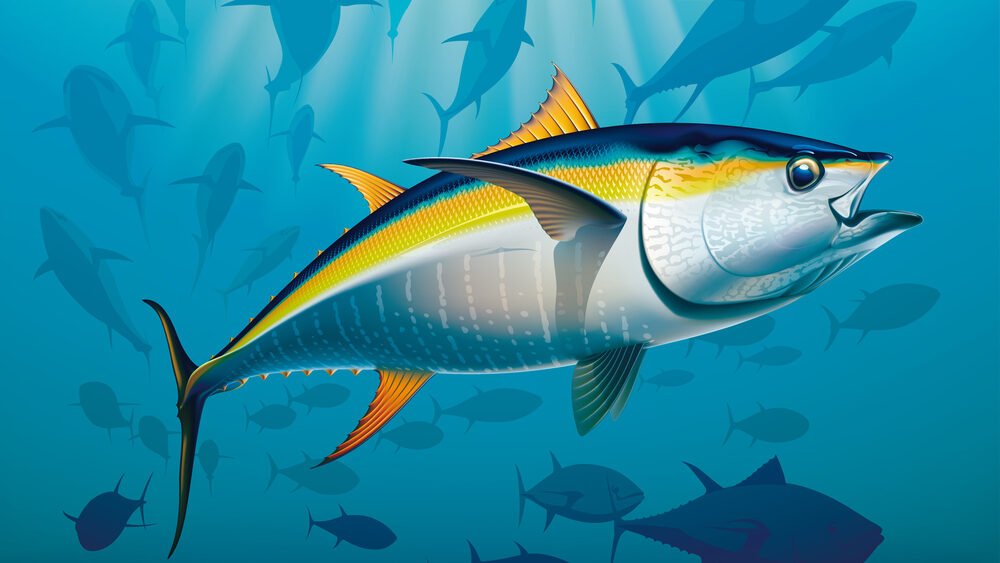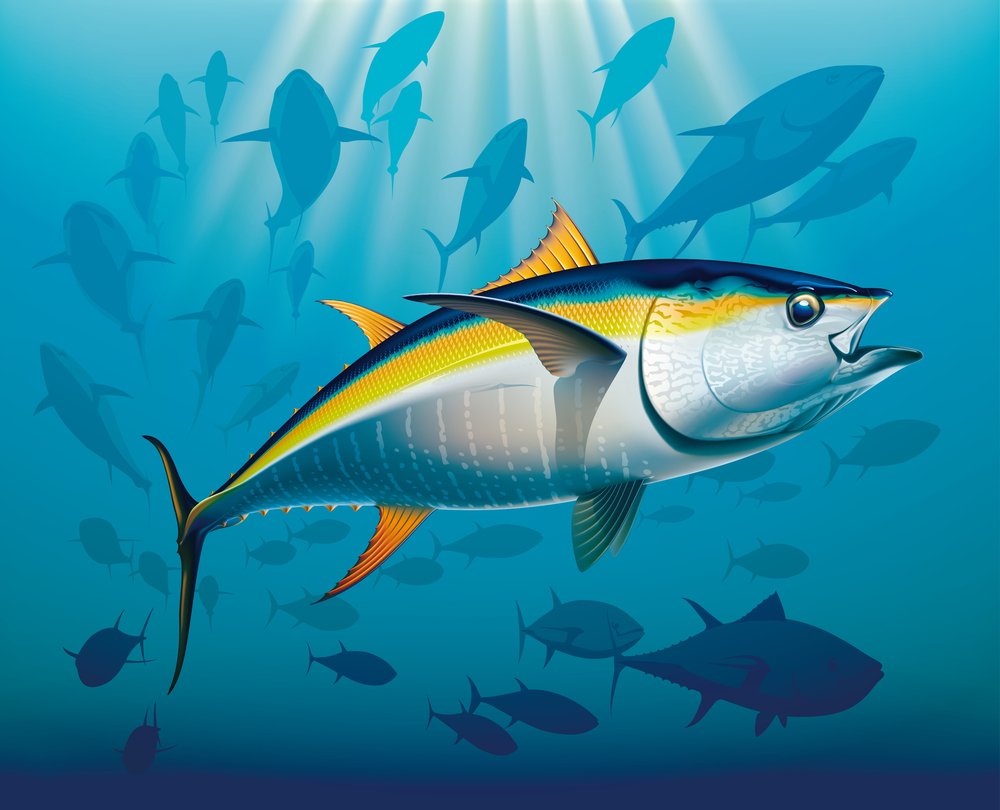Yellowfin Tuna (Ahi): Amazing Fun Facts, Habitat and FAQ
Yellowfin tuna is one of the most popular varieties of tuna in the world and can live in tropical water off the coasts of many countries. Yellowfin tuna is a smart seafood choice because it is sustainably managed and responsibly harvested.
9 Quick Interesting Yellowfin Tuna Facts:

- Fast swimmers: Can reach speeds up to 50 miles per hour
- The gestation period of only a few days
- Newly hatched fry are microscopic
- It has a lifespan of 6-8 years
- They are highly migratory
- Their biggest threat is overfishing
- Can dive to depths of 1000 meters to escape predators
- School with other tuna species
- Can breed the whole year
What is a Yellowfin Tuna?
The Yellowfin Tuna, also known as Ahi in Hawaiian, is a highly migratory fish with a lifespan of 6-8 years and a top speed of 50 miles per hour.
This pelagic fish travel in schools of fish, often with other tuna species, and feed on smaller fish, crustaceans, cephalopods, and mollusks. They are closely related to bigeye tuna.
Their population is estimated to be in the millions. Their gestation period of only a few days, and they can breed throughout the year.
Yellowfin Tuna are preyed upon by whales, sharks, seabirds, marlins, dolphins, humans, and other fish, and their biggest threat is overfishing.
Yellowfin Tuna Characteristics

The yellowfin tuna is an impressive and distinct species of fish that can weigh up to 180 kg (400 lbs) and grow to lengths of 2.4 meters (7 feet 11 inches).
Its unique characteristics are its bright yellow dorsal and anal fins that grow longer as it ages, its dark metallic blue body, silver-colored belly, and the vertical stripes on its side.
Habitat
Yellowfin tuna inhabit the open waters of the Pacific, Atlantic, and Indian Oceans, residing in the epipelagic zone above 100 meters or 330 feet in depth. They can be found in various locations worldwide, including mid-ocean islands around Hawaii, the Western Pacific, the Caribbean, the Maldives, and the Philippines.
Behavior
Yellowfin tuna is an aggressive predator that schools with other types of tuna.
While most of the time, the fish lives in the top 100 meters of the ocean, recent studies of their behavior using sonic tracking resulted in some unexpected discoveries. Yellowfin tuna occasionally make sudden deep dives down to depths as low as 1592 meters or 5223 feet. Experts believe that these occasional deep dives are a way for the tuna to evade any predators chasing them.
Scientific classification and Taxonomy

The Yellowfin Tuna’s scientific name is Thunnus Albacares, which translates to “white meat” and should not be confused with albacore (Thunnus Alalunga), another tuna species.
It is part of the subgenus Neothunnus, a yellowfin group that it shares with blackfin and longfin tunas.
The genus is Thunnus, which is often called “real tunas.”
It is part of the family of Scombridae with mackerel, tuna, and bonito.
Nine families make up the order Scombriformes in the class Actinopterygii, which classify all ray-finned fish.
- Kingdom: Animalia
- Phylum: Chordata
- Class: Actinopterygii (ray-finned fish)
- Order: Scombriformes (nine families make up this order)
- Family: Scombridae (mackerel, tuna, and bonito family)
- Genus: Thunnus (specifically real tunas)
- Subgenus: Neothunnus (Yellowfin group consisting of yellowfin, blackfin, and longfin tuna)
- Species: T. albacares or Thunnus albacares (Yellowfin Tuna)
Yellowfin Tuna Conservation status
The yellowfin tuna’s conservation status is classified as “Least Concern” by the IUCN. In some areas, such as the Philippines and the Indian Ocean, fishermen overfished, and the population declined.
The juvenile yellowfin tuna school with other tuna species, such as skipjack and bluefin, so they are particularly vulnerable to overfishing and being caught as bycatch. Because young fish are caught before spawning, it significantly impacts the yellowfin tuna population.
While the yellowfin tuna is an important food source, it also serves a vital role as a predator in maintaining a balanced marine environment.
Commercial Fishing and Ocean Fishery

Commercial tuna fishing is an important industry, with the species being one of the most caught worldwide. Yellowfin tuna is smart seafood because it is responsibly harvested under U.S. regulations and sustainably managed globally by Regional Fisheries Management Organizations (RFMOs), which are responsible for the management of tuna in 91% of the world’s ocean surface area. Commercial fishing regulations in some regions prohibit some fishing techniques to reduce bycatch.
The yearly fishing of yellowfin tuna is estimated to be:
- 408,000 metric tonnes in the Indian Ocean
- 462,000 metric tonnes in the Asian half of the Pacific Ocean (Western and Central Pacific)
- 229,000 tonnes in the American half of the Pacific (Eastern Pacific)
- 109,000 metric tonnes in the Atlantic Ocean.
It is caught near the surface using purse seine and longline.
It is a popular choice for raw sashimi. Smaller yellowfin tuna are often canned, and larger yellowfin of higher quality tend to be shipped fresh to seafood markets in Asia.
Not only is the yellowfin tuna a vital food source, but as a predator, it also serves a vital function in maintaining balance in the marine food chain and environment.
Yellowfin Tuna as Food and Nutrition

Yellowfin tuna is a popular fish highly valued for its firm texture and mild flavor.
You can prepare it in many ways, including raw as sashimi, sushi or poke, seared, grilled, broiled, sauteed, or dried.
Nutritionally, yellowfin tuna is a great choice, as it contains a lot of lean protein, is low in saturated fat and sodium, and is rich in a variety of vitamins and minerals, as well as decent amounts of omega-3 fatty acids.
Mercury Levels
Yellowfin tuna’s mercury levels vary depending on the size and age of the fish, as well as the fishing location.
According to Healthline.com, yellowfin tuna’s mercury level in PPM (part per million) is 0.354. A serving of 3 ounces or 85 grams of yellowfin tuna contains about 30 micrograms (mcg) of mercury, which is half the amount of mercury compared to bigeye tuna, and about 2.5 times higher than skipjack tuna.
The U.S. Environmental Protection Agency (EPA) lists 0.045 mcg per pound, or 0.1 mcg per kg of body weight per day, as the maximum safe mercury dose.
For example, if you are 130 pounds or 59 kg, according to the EPA, you can consume up to 5.85 micrograms per day. Following the EPA recommendations, you should limit your consumption of yellowfin tuna to one serving of 3 ounces or 85 grams every 5-6 days if that is the only source of mercury you consume if you weigh 130 pounds. If your weight is 175 pounds or 79 kg, you should limit one serving to every four days.
The EPA recommends pregnant, and breastfeeding women avoid high mercury food such as tuna and limit “good choice” seafood such as yellowfin tuna to a maximum of one serving per week.
Generally speaking, younger yellowfin tuna have lower levels of mercury than larger tuna.
Canned yellowfin tuna are mostly younger, smaller fish with lower mercury levels, whereas adult yellowfin tuna are sold fresh in markets.
Frequently Asked Questions

How big do yellowfin tuna get?
The world record is 193.68 kg or 427 lbs, caught in Cabo San Lucas, Mexico, in 2012, and the fisherman won a $1 million prize.
How to cook and prepare yellowfin tuna?

Cooking and preparing yellowfin tuna is an easy process. For the best flavor, buy fresh tuna. If using frozen tuna, make sure to thaw it thoroughly before cooking. Cut the tuna into steaks or cubes. Pan-searing allows you to lock in moisture and flavor. Heat a skillet or nonstick pan with oil to medium-high heat. Add the tuna and let it sear for about 3 minutes per side for steaks or 2 minutes per side for cubes. Be careful not to overcook, as it becomes dry and tough. Then bake it in the oven at 350°F for 8 minutes or poaching in simmering water for 5 minutes. Serve with your favorite sides, and enjoy!
How much Ahi tuna is safe to eat?

It depends on your weight, the mercury level of the tuna you consume, and what other food you eat during the week. If you only eat Ahi Yellowfish Tuna, the EPA recommendation is one serving of 3 ounces or 85 grams per week.
Does yellowfin tuna have mercury?
Yes, about 30 micrograms per serving of 3 ounces or 85 grams.
How to catch a yellowfin tuna?

First, get a boat and paddle or sail to the fish’s habitat, the open ocean near the surface. Second, use a high-quality rod and reel with a heavy line. Third, use live bait to attract the fish, such as squid or mackerel. Fourth, let the line out and wait until the rod or line moves. Fifth, quickly reel it in while keeping tension so the tuna hooks properly. Sixth, fight the fish until it gets exhausted, and bring it into the boat safely. It can be a heavy and robust fighter so you may need help.
How does yellowfin tuna taste?

Its flesh has a mild taste and firm texture but easily separates when cooked correctly.
Does ahi tuna have omega 3?
Yes. It has decent omega-3 fatty acids, both EPA (eicosapentaenoic acid) and DHA (docosahexaenoic acid).
How to tell the difference between bluefin tuna and yellowfin tuna?

Both fish are famous for sushi and belong to the same genus, but there are a few key differences.
The bluefin tuna is dark blue and almost black on its back, with white or silver sides and a pale belly, and can grow to be 40-70 kg heavier than the yellowfin.
There are also some slight differences between the types of bluefin tuna, such as the Atlantic bluefin tuna, the Pacific bluefin tuna, and the Southern bluefin tuna.
Can I eat yellowfin tuna while pregnant or breastfeeding?
This is not medical advice. The EPA recommends limiting the consumption of food with mercury while pregnant or breastfeeding. Read more about mercury levels above.

